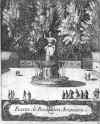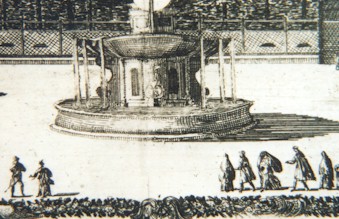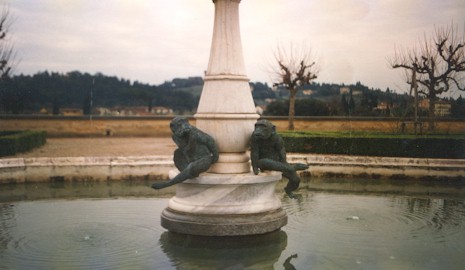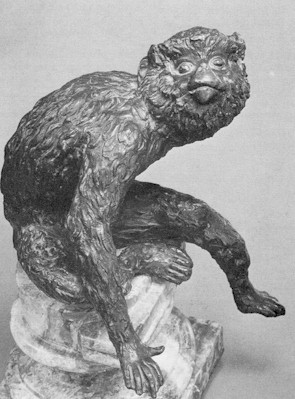|
Louis Meusnier 1665 engraving of the fountain

Bibliotheque
nationale de France photographic plate, offered by kind permission.
Now for those who like detective stories, a
real life mystery. Around the four sides of this rather small fountain are four niches or
alcoves, but what was in them is long gone. Engravings of the fountain in Aranjuez in 1665
by Louis Meusnier even then showed the niches to be empty but a pen and wash drawing in
the Uffizi Gallery, Florence, shows they contained seated monkeys in different poses. We
may confidently expect a monkey by Giambologna in his favourite material, bronze, to be
superb, to match the quality of the Samson and a Philistine and impress other artists in
the competitive atmosphere of Florence. For Giambologna, always ambitious, was said in the
16th century to have surpassed Michelangelo.
Details of
engraving

In fact Giambologna succeeded in carving a Samson
and a Philistine whereas Michelangelo only left drawings and models of this subject in
terracotta and there are various bronze casts in existence, perhaps taken from his wax
models. The Samson and a Philistine was discovered in 1907 by Signor PN Ferri and the
fountain in Spain was discovered by the writer Bertha Wiles as recently as 1929. The
missing monkeys were first identified by Giambologna experts as those of the three monkeys
on the Fontana delle Scimmie in the Boboli Gardens in Florence but their poses are not
suitable for a niche and the attribution could not be sustained.
Monkey Fountain,
Boboli Gardens

Some years ago another discovery
was made by Giambologna experts
and a hypothesis was put forward that a monkey in the Louvre and another in Berlin (State
Museum Dahlem) of the same model but with a different worked up state were of a quality
sufficiently high to be considered to be two of the missing monkeys. The Berlin monkey was
exhibited in the Giambologna Exhibition 1978/79 at the V&A (catalogue entry No 182,
page 194) but is now considered to be a later copy. Blessed by the Louvre and hallowed by
time, hypothesis has become fact and most Giambologna experts seem to accept the Louvre
monkey as "right", the quality acceptable. It has become part of the accepted
canon of his work. The mystery has been solved. Or has it?
Berlin Monkey,
State Museum Dahlem

The writer of this article purchased in an auction
(7) some years ago two small bronze monkeys, which gave every indication of age, both with
the same pose, with numerous plugs and serious corrosion inside and outside, and seated on
20th century wood bases. Beneath the dirt and grime they appeared to be of high
quality. A closer examination after cleaning confirmed there was a precision of casting, a
subtlety and richness of texture and a nobility of pose which in itself was interesting
but was made disturbing by the raised right arm and finger pointing upwards with its
unmistakable resemblance to Giambologna’s famous Mercury. It was obvious from their
weathered appearance that they had been outside but who would put two small monkeys
outside where they could so easily be stolen? It would have had to be in a protected area,
not a public place. Why the curious curved base, where do the yellow deposits come from?
They were worth investigating. Could these two mysterious monkeys be candidates for that
niche? These are questions for the intellectually curious.
We can surmise that being a Medici commission, the
four missing monkeys from the fountain would be unique as they would have been made only
for this fountain and once lost their history would be lost. If they were on the fountain
for fifteen years 1569-1584 the window of opportunity for contemporary copies or later
aftercasts to be made in succeeding centuries was severely limited. There are fine
contemporary bronze models by Giambologna of his famous marble Rape of the Sabines 1583
(8) but there do not seem to be contemporary bronze models of the marble Samson and a
Philistine (9). The copyright applied to the Samson may have applied to the four monkeys.
The four monkeys, once detached from the fountain, could have travelled through the centuries in their original weathered state
until their potential was recognised.
Although Giambologna was a favoured artist of the
Medici he was still treated as an employee, Francesco de Medici wrote forcefully to him to
return to Florence from Bologna to complete work he had already started. To get to the
truth perhaps we ought to review this matter. With the monkeys missing for 400 years
obviously no-one, even experts, could know much about them, their style, condition, size,
pose, etc but a picture can be formed of what we don’t know from what we do and we
can carefully lay out the criteria. We can visit the fountain at Aranjuez and see its
material, examine and measure the niches carefully and estimate the size of the missing
monkeys from the dimensions of the niche and the size of the fountain. We can obtain a
good copy of the Uffizi drawing and study it carefully, even have the photograph enlarged,
after all the drawing is the only recorded source to offer guidance as to the resemblance
of what the finished works were to look like. We can look into the history of the fountain
to estimate how long the monkeys were in the open as it might have a bearing on their
condition. We can examine the variety of styles that Giambologna used in the 1560’s.
The monkeys can be submitted for scientific
examination. The human eye has its limitations and trying to date metal by eye alone is
not always wise. The monkeys can only be understood if studied carefully and meticulously.
Delaying judgement on their authenticity until all the facts are known is better than to
give an instant opinion.
In his Essay concerning Human Understanding John
Locke (1632-1704) said:
"New opinions are always suspected and usually opposed
without any other reason but because they are not already common." |